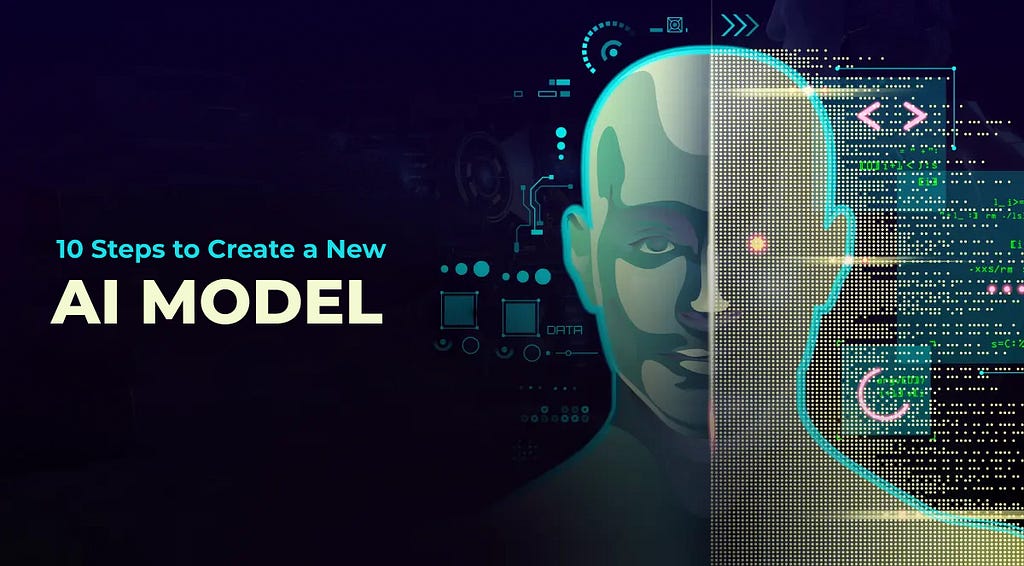Step into the world of AI development with our guide detailing 10 vital steps to create a new AI model in 2025. Learn the best practices today!
 10 Steps to Create a New AI Model in 2025
10 Steps to Create a New AI Model in 2025Artificial Intelligence (AI) continues to evolve at a remarkable pace, driving innovation across industries. In 2025, creating a new AI model will involve leveraging cutting-edge tools and methodologies, allowing developers and data scientists to build more efficient, accurate, and scalable models. Whether you’re working in healthcare, finance, or any data-driven sector, mastering the process of AI model creation is critical to staying ahead in this dynamic field.
In this article, we’ll walk you through 10 essential steps to create a new AI model in 2025, helping you understand the process from data gathering to model deployment and beyond. Incorporating the latest advancements in AI development, these steps will provide a comprehensive guide to developing state-of-the-art AI models that address real-world challenges.
1. Define the Problem and Objective
Before diving into the technicalities, the first and most crucial step in creating a new AI model is to clearly define the problem you are trying to solve. Whether you’re building an AI model to predict customer behavior, improve medical diagnoses, or optimize supply chain processes, having a precise understanding of the problem will shape the rest of the development process.
Specify your goals: What do you want the AI model to achieve? Are you aiming for classification, regression, or clustering?
Define metrics for success: Determine the key performance indicators (KPIs) or accuracy measures that will be used to evaluate the AI model’s performance.
By framing the problem, you set a foundation for your project, which will inform the type of model you build, the data you use, and the tools required.

2. Collect and Prepare the Data
Data is the backbone of any AI model, and one of the most critical steps to create a new AI model is gathering high-quality, relevant data. In 2025, data collection is more sophisticated than ever, with AI itself being used to streamline this process through automated data scraping, real-time data pipelines, and advanced data synthesis techniques.
Data collection methods: Use APIs, web scraping, IoT devices, and other automated tools to gather large datasets.
Data types: Depending on your problem, data could be structured (like numerical tables) or unstructured (like text, images, and video).
Data cleaning: Remove duplicates, fill missing values, and ensure consistency to maintain high data quality.
Data labeling: For supervised learning models, ensure that data is correctly labeled to train the model.
The quality and diversity of your data will greatly affect the outcome of your model, so spend time ensuring it is accurate, comprehensive, and well-prepared.
3. Choose the Right Tools and Frameworks
In 2025, a wide range of AI development tools and frameworks will be available, making it easier to create a new AI model. Selecting the right tools is crucial to optimize model development, testing, and deployment. Here are a few of the most widely used tools:
TensorFlow: A flexible framework widely used for building and training deep learning models.
PyTorch: A dynamic computational framework preferred for research and real-time AI model development.
Keras: A high-level API built on top of TensorFlow, which simplifies model creation.
Hugging Face Transformers: Specializes in Natural Language Processing (NLP) models and other transformer-based architectures.
Choose the tools that best suit your model requirements. If you’re working with image recognition, for example, frameworks like TensorFlow or PyTorch may be more suitable, while Hugging Face is ideal for NLP tasks.
4. Preprocess and Augment the Data
Once you have collected your data, the next step is to preprocess it to make it suitable for training your AI model. Data preprocessing includes tasks such as normalization, transformation, and scaling, ensuring that the data is in a format that the AI model can understand.
Normalization: Adjust the data to ensure all features are within the same range.
Scaling: Scale down or standardize large datasets to improve processing efficiency.
Feature engineering: Create new features or derive insights from existing ones to improve the model’s predictive capabilities.
In 2025, data augmentation techniques will also play a key role. For instance, in image recognition, generating additional training images through rotation, cropping, and flipping will enhance model robustness and reduce overfitting.
5. Select the Appropriate Algorithm
The choice of algorithm depends largely on the nature of the problem you’re addressing. In 2025, there will be a broad spectrum of algorithms ranging from traditional machine learning techniques to advanced deep learning models. To create a new AI model, consider the following:
Supervised Learning: For problems with labeled data, use algorithms such as Decision Trees, Support Vector Machines (SVM), or Neural Networks.
Unsupervised Learning: For clustering and association tasks, algorithms like K-means clustering or DBSCAN are often used.
Reinforcement Learning: Ideal for decision-making tasks where the model learns by trial and error (e.g., game strategies or autonomous driving).
Deep Learning: For more complex tasks such as image recognition, voice synthesis, or language translation, convolutional neural networks (CNNs) or transformers are appropriate choices.
Selecting the correct algorithm is crucial, as it will influence the model’s complexity, training time, and accuracy.
6. Train the AI Model
Training the model is where the real AI development begins. During this step, the AI model learns from the training dataset by adjusting its internal parameters to minimize error and improve accuracy. In 2025, advanced techniques such as distributed training and federated learning will enable faster and more efficient training processes.
Split the dataset: Divide the dataset into training, validation, and test sets (commonly 70% training, 15% validation, and 15% testing).
Hyperparameter tuning: Optimize parameters like learning rates, batch size, and number of layers for deep learning models.
Use cloud services: Take advantage of cloud platforms like Google Cloud AI, AWS SageMaker, or Azure Machine Learning to speed up training with distributed computing.
Ensure that the model doesn’t overfit by generalizing well to new, unseen data.
7. Evaluate the Model
Once the training process is complete, it’s time to evaluate the model’s performance. Evaluation metrics are essential to understanding how well your AI model performs on unseen data and how it will behave in real-world scenarios. Some common evaluation metrics include:
Accuracy: Measures the percentage of correct predictions.
Precision and Recall: Precision measures the correctness of positive predictions, while recall measures how many true positives were identified.
F1 Score: Balances precision and recall, offering a more complete understanding of model performance.
Confusion Matrix: Visualizes the performance of a classification model.
In 2025, the evaluation will also include model interpretability, using techniques like SHAP (Shapley Additive Explanations) or LIME (Local Interpretable Model-agnostic Explanations) to understand how and why models make certain decisions.
8. Optimize the Model
After evaluating the initial results, the next step is to fine-tune the model to improve its performance. Model optimization may include a range of techniques, such as:
Hyperparameter tuning: Use grid search or random search techniques to find the best combination of hyperparameters.
Cross-validation: Train the model on multiple subsets of data to ensure it generalizes well.
Regularization: Use techniques like L1 and L2 regularization to penalize large weights and avoid overfitting.
Ensemble Methods: Combine the predictions of multiple models (e.g., bagging, boosting, or stacking) to improve accuracy.
In 2025, AI development will likely leverage AutoML (automated machine learning) tools to streamline the model optimization process, making it faster and more efficient.
9. Deploy the AI Model
Once your model has been trained and optimized, the next step is to deploy it for real-world use. Model deployment involves integrating the AI model into production environments where it can make predictions or provide insights in real-time.
API Deployment: Convert your AI model into an API that can be accessed via web services for applications like chatbots, mobile apps, or software platforms.
Cloud Deployment: Use cloud services like AWS, Google Cloud, or Microsoft Azure to host the model, ensuring scalability and accessibility.
Edge Deployment: For applications requiring low latency, deploy AI models at the edge (e.g., on IoT devices or local servers) to reduce response times.
In 2025, models will increasingly be deployed as part of AI-as-a-Service (AIaaS) platforms, allowing businesses to leverage AI capabilities without significant infrastructure investments.
10. Monitor and Update the Model
Even after deployment, an AI model requires ongoing monitoring to ensure it continues performing as expected. Over time, the model may encounter changes in the data distribution, making it less accurate. To maintain its effectiveness, it’s essential to track model performance and update it as needed.
Monitor performance: Use tools to track model accuracy, response time, and resource usage in real-time.
Retrain the model: Periodically retrain the model with fresh data to keep it up-to-date.
Error analysis: Regularly assess where the model is failing and make adjustments as needed.
In 2025, AI models will increasingly be integrated with self-learning mechanisms, allowing them to adapt to new data and conditions without human intervention, creating more autonomous and scalable solutions.
Conclusion
Creating a new AI model in 2025 requires a structured approach that leverages advanced tools, algorithms, and frameworks to build models that are not only accurate but also scalable and adaptable. From defining the problem and collecting data to training, optimizing, and deploying the model, these 10 steps will guide you through the process, ensuring your AI development efforts lead to successful, real-world applications.
By following these steps, you can confidently navigate the complexities of AI development, build cutting-edge models, and keep pace with the ever-evolving field of artificial intelligence.
10 Steps to Create a New AI Model in 2025 was originally published in The Capital on Medium, where people are continuing the conversation by highlighting and responding to this story.

 3 hours ago
13
3 hours ago
13







 English (US) ·
English (US) ·